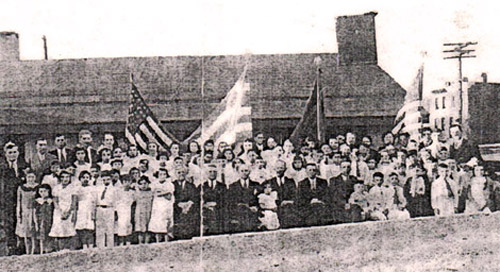
Commemorating its 60th Anniversary
A Brief History of St. Nicholas Greek Orthodox Church
By William G. Poulos
Introduction
The Greek Orthodox Church has always been the living repository, protector and disseminator of the Hellenized Christian civilization it inherited from Byzantium. This was particularly true during the dark period of Islamic domination of Greece.
Following the Ottoman rule of Greece and the establishment of a Greek national state in 1832, the Church's critical role in preserving and advancing Orthodox Christianity, the spirit of Hellenism and a renewed Greek culture blossomed. Its pivotal role as the center and focus of the Greek experience continued as it was transplanted to other nations in the late nineteenth and early twentieth century by Greek immigrants who left their homeland in order to build new lives for themselves.
This was especially the case as Greek immigrants came to the United States and brought their beloved Orthodox Church and Greek culture and institutions with them. The synergy between these Old World spiritual and intellectual values 'and American democratic freedom and idealism would bear much fruit.
Nowhere was this vital interaction of the two cultures more evident than in Baltimore, Maryland, where, as early as the turn of the century, Greek immigrants settled. By the 1920s a relatively small but vibrant and industrious Greek community was thriving. This population grew dramatically through the 1930s and 1940s, as new Greek immigrants were attracted to Baltimore's economic opportunities.

OUR GREEK CHURCH AT HOMEWOOD AVE. 1935-1936.
Each new wave of arrivals either found work in area industries or opened small, then larger businesses, some of which are still in operation today. These immigrants, as earlier ones had done, began raising and educating their children. Eventually many of these children, the first generations of Baltimore-born Greek Americans entered the ranks of the legal, medical, scientific and other professions.
The spiritual needs of this burgeoning community were met primarily by the Church of the Annunciation, which was founded in 1906, and by 1909, had acquired a permanent Church building located at Homewood Avenue and Chase Street. In 1937, the Church moved to its present location at Maryland Avenue and Preston Street.
During the 1920s, members of the Annunciation who left the congregation as a result of the royalist-republican controversy in Greece, founded a second Greek Orthodox Church: The Church of the Holy Trinity. By 1930, the two congregations were once again reunited into a single spiritual community, The Church of the Annunciation. The clergy and laity of the Annunciation would eventually play a significant role in the establishment of the parish of St. Nicholas.
From 1940 to the early 1950s the Greek Orthodox community in the Baltimore area continued its rapid growth, particularly in the southeastern part of the city known as Highlandtown. This expansion and concentration of Greek families in this area was a critical factor in the creation of our St. Nicholas Church.


 History
History
